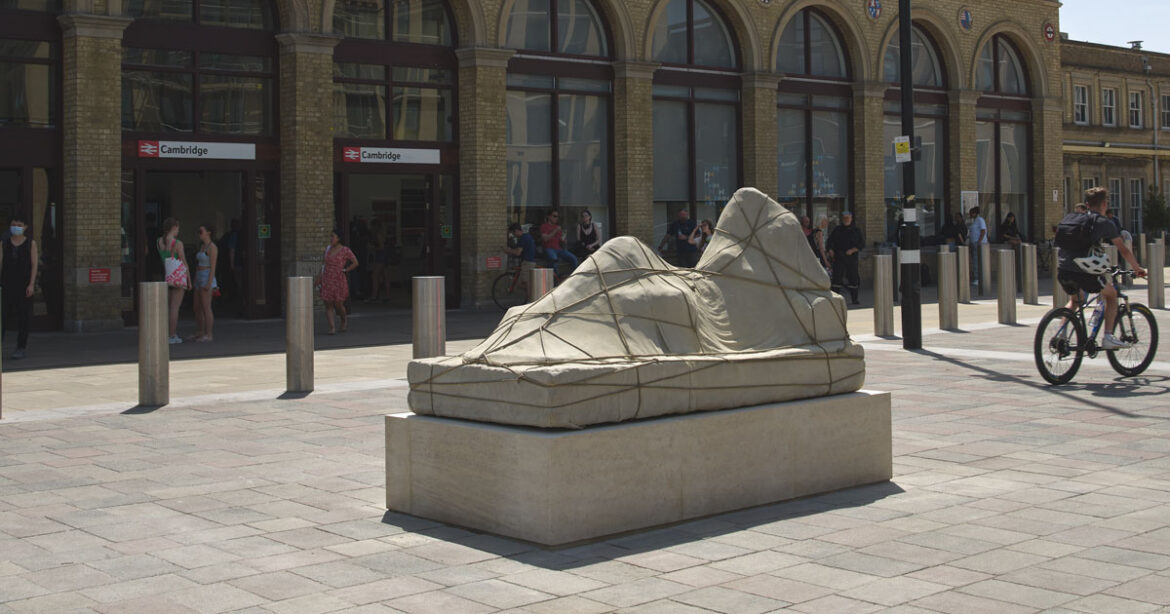Alex Fice speaks to Gavin Turk about his current exhibition at The Heong Gallery, which unwraps the story behind his new sculpture outside Cambridge Train Station
Though one of the most accessible forms of art, public sculpture is often overlooked or subconsciously obscured from view. The latest exhibition at The Heong Gallery, In Search of Ariadne, plants the spotlight firmly on a new, permanent installation by artist Gavin Turk outside Cambridge railway station, which provides a starting point for questioning our preconceptions about art, form and meaning.
Ariadne Wrapped is a painted bronze sculpture that depicts a reclining figure draped in a cloth and wrapped in string, like a parcel in transit. The sculpture’s reclined form is one that has been documented frequently throughout art history, from Michelangelo to Henry Moore. Toying with our sense of recognition for a familiar form, Gavin subverts expectations by literally covering it from view, shrouding the figure in an air of mystery and obscuring detail.
The exhibition at The Heong Gallery explores metaphysical, art historical and social underpinnings of Ariadne Wrapped, by situating the sculpture in the context of Gavin’s past work and exploring the influences of other artists’ fascination with the reclined figure. “While looking at paintings by Giorgio de Chirico, I found not only the recurring motif of a colonnade – which suddenly I noticed in the building of Cambridge station – but also this archetypal sculpture of a reclining woman,” says Gavin. “In the paintings, this figure is generally centre-stage, but not clearly defined – often it’s crudely painted and lumpen, which sort of reinforces the idea that it’s symbolic of something.”
As Gavin did more research into the figure, he discovered the link to Ariadne, a character in Greek mythology known for giving Theseus a ball of thread to help him find his way back out of the Cretan labyrinth when he goes in search of the Minotaur. After Theseus finds his way out of the maze, he takes Ariadne with him on his journey back to Athens – only to abandon her on the island of Naxos. The reclined figure represents the moment Ariadne awakens to the realisation that Theseus has left her, before being taken away by Dionysus as his consort.
For Gavin, Ariadne’s role in Greek mythology as the interpreter of the labyrinth makes her an appropriate symbol or starting point for the process of unravelling representation itself. The exhibition continues this thread, inviting visitors to search for and question their preconceptions of art, sculpture and the wider world.
“A lot of my work revolves around the idea that people are going to come to it with a whole lot of art in their head, which will affect the way they see things,” he says. “I want to give them a mechanism to unpick their misconceptions, presenting them with the idea that art might be a tool that helps people challenge preconceptions, ideologies, or points of closure – where they think reality and truth lie.”
In Gavin’s work, classical storytelling provides a useful lens through which we can begin to question our present situation. “At the moment, there seems to be a big need to look forwards and towards a human evolution, or transition towards a slightly different way of thinking. I suppose I’m taking people back to a point in the past, in the hope it might be a key to leading us towards a more positive future.”
In Search of Ariadne opens on 6 October. The Heong Gallery is open Wednesday to Sunday, 12-5pm and is free to visit

